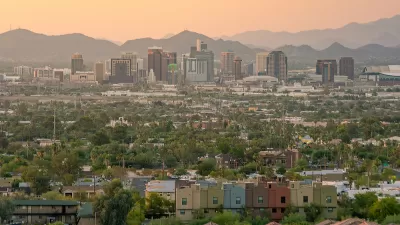AVs are more than a transportation issue and will have significant impacts on real estate. Expect AVs to affect parking, sprawl, housing prices, and transit.

An ongoing question with AVs is how they will affect real estate. Below is a brief list of issues to consider. Look out for an upcoming post that will add e-commerce and sharing economy impacts as well.
- Parking – if we move towards an even partial model of shared vehicles (i.e. Lyft, Uber, Via, Chariot) there will be a substantial reduction in the need for parking (see earlier posts here and here). Studies have shown this dropping down to as low as only needing 10-15% of current parking spaces (and here). This change would open up a tremendous amount of land for redevelopment (parking is the single largest land use in most cities), hence dramatically increasing supply and – one would think – decreasing land values. In addition, as parking needs diminish and parking regulations move to requiring less – or no – parking, constructions costs will also drop dramatically. Parking can cost about 4k$ per spot for on-grade parking and up to 18-20k$ per spot for structured parking, can be a significant proportion of construction costs, and typically requires additional land acquisition.
- Sprawl – several studies have shown that AVs could increase suburban sprawl as people can drive further, faster and might be willing to accept a longer commute as they can now use their time in the car for things other than driving. If that is the case, there will be an increased pressure on sprawl and the metropolitan footprint would expand dramatically. Again, this constitutes an overall increase in available/feasible land supply which – given the rules of economics – lead to a drop in land value. Arguably, this would not be the same everywhere as land that will have all of a sudden become available for development would see large price increases while places that are already close enough or within to cities would see land prices drop due to increased competition.
- Housing Prices – Given the points above, housing prices should decrease. As land prices and construction costs drop, housing rents and prices will also drop. This could be a boon for affordable housing concerns across the country (for example, each parking spot included in rent equates to about 225$), but could also cause substantial disruptions to existing markets and developments/projects.
- End of TODs? – One unknown effect of AVs will be how it changes transit. On the one hand, this new technology could be a boon for transit as it helps solve transit’s perennial first/last mile hurdle. Lyft can get people to the train, light rail, or bus station, increasing catchment areas and boosting ridership. On the other, riders may simply decide to stay in that Lyft all the way to their destination – especially as the price of the trip drops dramatically as technology replaces the highest cost of the trip – the drivers. Preliminary reports from New York and San Francisco point to this trend, with transit ridership diminishing as Transportation Network Company (TNC) use skyrockets. Some studies have shown a decrease of up to 43% of transit ridership – potentially the death knell of transit as we know it. In addition to this concern, is simply the potential atomizing of transit. What happens when multiple rider/route services such as Via and Chariot (or Lyft-line and Uber Pool – the carpool versions of Lyft and Uber) grows and we now have 8-12 passenger vans zipping through cities, delivering people directly to where they want to go and not to a bus stop a few blocks or a few miles away. If this happens, the activity/energy clustering and focusing role of transit would diminish as would the price premiums that are associated with transit proximity and transit oriented development.
- Location, Location, Location? – A looming question with not only AVs but the entire shift to mobility as a service is that mobility will become easier and more affordable. As that happens, the friction of transportation – which is one of the factors that creates the value of location – will diminish. This does not necessarily mean that current activity centers and draws will reduce in value, but any value based solely on the broader proximity aspects of location may diminish. This will increase the role of the quality of places and the buzz of related activities in determining location value.
A significant issue to consider in all of this is not only the end state change of AV impacts, but also the transition period. In terms of real estate, a glaring concern would be projects caught during this time. Projects that have built parking in consideration of today’s reality may find themselves with decreased parking revenues (that is already happening with Lyft and Uber) and unable to repay long-term mortgages or bonds. In addition, these projects will be competing with future projects that did not need to build parking and/or benefited from reduced land costs. The last projects built with today’s constraints – and not future-proofing the coming disruptions – will be the ones most punished by this rapid change.
All of this points to a dramatically shifting landscape for real estate. A large question is both what direction these changes will take and – as importantly – how quickly will they come about. Of concern is not only the shifting market conditions, but also the regulations that currently help shape that market and the speed at which those typically change. What happens if parking utilization needs drop dramatically over a short period of time. How quickly will parking requirements shift with that? And what kinds of political battles will meet these changes as developers and property owners with existing properties fight these changes to protect their competitiveness.
FULL STORY: AVs and Real Estate - A Guide to Potential Impacts

Planetizen Federal Action Tracker
A weekly monitor of how Trump’s orders and actions are impacting planners and planning in America.

Congressman Proposes Bill to Rename DC Metro “Trump Train”
The Make Autorail Great Again Act would withhold federal funding to the system until the Washington Metropolitan Area Transit Authority (WMATA), rebrands as the Washington Metropolitan Authority for Greater Access (WMAGA).

DARTSpace Platform Streamlines Dallas TOD Application Process
The Dallas transit agency hopes a shorter permitting timeline will boost transit-oriented development around rail stations.

San Francisco's School District Spent $105M To Build Affordable Housing for Teachers — And That's Just the Beginning
SFUSD joins a growing list of school districts using their land holdings to address housing affordability challenges faced by their own employees.

Car-Centric LA Suburb Looks to a Train-Oriented Future
City leaders in Rancho Cucamonga, the future western terminus of the Brightline West rail line to Las Vegas, want to reimagine the city as a transit-oriented, pedestrian-friendly community.

New Alaska Bitcoin Mine Would Burn as Much Energy as the State’s Largest Coal Plant
Fueled by “stranded” natural gas, the startup hopes to become the largest in the US, and to make Alaska an industry center.
Urban Design for Planners 1: Software Tools
This six-course series explores essential urban design concepts using open source software and equips planners with the tools they need to participate fully in the urban design process.
Planning for Universal Design
Learn the tools for implementing Universal Design in planning regulations.
Municipality of Princeton
Roanoke Valley-Alleghany Regional Commission
City of Mt Shasta
City of Camden Redevelopment Agency
City of Astoria
Transportation Research & Education Center (TREC) at Portland State University
US High Speed Rail Association
City of Camden Redevelopment Agency
Municipality of Princeton (NJ)





























